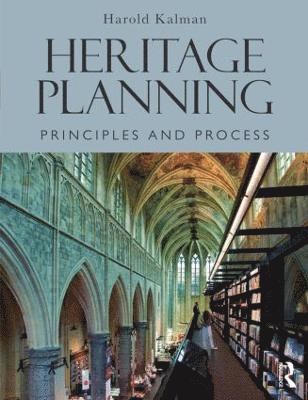
- Format
- Häftad (Paperback / softback)
- Språk
- Engelska
- Antal sidor
- 344
- Utgivningsdatum
- 2016-12-12
- Förlag
- Routledge
- Illustratör/Fotograf
- 125 black & white halftones 18 colour tables
- Illustrationer
- 18 Tables, color; 125 Halftones, black and white
- Dimensioner
- 244 x 188 x 25 mm
- Vikt
- Antal komponenter
- 1
- ISBN
- 9781138017924
- 981 g
Heritage Planning
Principles and Process
Kundrecensioner
Fler böcker av Harold Kalman
-
Exploring the Capital
Andrew Waldron, Peter Coffman, Harold Kalman
The many and varied threads of Canada's national life come together in its capital region. Where the Rideau River flows into the Ottawa River, an Algonquin community was visited by French explorers and settled by British colonists. The town grew i...
-
Exploring Vancouver
Harold Kalman, Robin Ward
Recensioner i media
"[I]t is worth the investment of time to read this well-written and engaging historic account and to draw inspiration and insight from the challneges encountered in shaping our collective understanding of significance." - Bulletin of the Association for Preservation Technology, Amalia Leifeste, Clemson University/College of Charleston, USA "Organized in a straightforward and accessible manner, with handsome illustrations and a generous use of real-life examples, it provides a clear overview of how to manage change at historic places. With its focus on built heritage, it will appeal particularly to architects and planners" - Montira Horayangura Unakul, UNESCO in Traditional Dwellings and Settlements Review
Innehållsförteckning
Table of Contents PREFACE 1 HERITAGE PLANNING 1.1 The Setting of Heritage 1.2 Organization of the Heritage Sector 2. CONTEXT 2.1. Legal and Planning Infrastructure 2.2 Sustainability 2.3 Ethics 3. BEST PRACTICES 3.1 Charters and Conventions 3.2 Conservation Treatments Principal treatments Other treatments Combining treatments 3.3 Standards and Guidelines 4. UNDERSTANDING THE HISTORIC PLACE 4.1 Historical Research 4.2 Physical Investigation 4.3 Community Engagement 4.4 Heritage Values 4.5 Significance 5. MANAGING CHANGE 5.1 Defining Project Goals 5.2 Identifying a Use 5.3 Selecting a Conservation Treatment 5.4 Tools and Incentives 5.5 Risk Assessment 5.6 Heritage Impact Assessment 5.7 Implementation Plan 5.8 The Conservation Plan 5.9 Design, Construction, and Beyond SOURCES INDEX
Du kanske gillar
-
Peak Human
Johan Norberg
Inbunden -
Peak Human
Johan Norberg
Pocket
